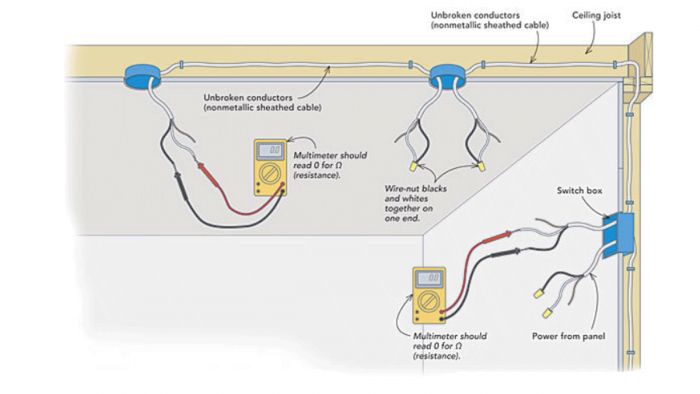What Should I Do if a Tripped Circuit Breaker Won’t Reset?
Electrician Brian Walo explains what to do next to ensure that a faulty electrical circuit in your house is safe and working properly.

Q:
The breaker will not set for the circuit containing my basement lights. I’ve replaced the switch and breaker, plus I’ve checked all fixtures for debris that may have dropped down across the contacts. The 15-amp circuit includes four ceramic light fixtures, relatively new nonmetallic sheathed cable, and one switch. Any ideas for what I should try next?
Charles Bickford, Ivoryton, CT
A:
Electrician Brian Walo responds: If you’ve checked the lights, the switch, and the breaker, you’ve got a short in the line. I recommend checking the individual runs of wire from the panel to the switch box, the lights, and so on for faults by using a multimeter.
Begin by shutting off the power to the circuit and disconnecting it so that it can’t become energized. If you’re familiar enough with a panel to swap out a breaker, I assume you can disconnect it. Remove all the lights, and unbundle any twisted wires so that you have lengths of wire from point to point that don’t contact any other wires.
Wire-nut one end of the run of nonmetallic sheathed cable to close a loop halfway, then set the multimeter to ohms (resistance) so that you can check the continuity of the section of cable. If you wire-nut the black and white together on one end and get a zero reading on the other, it means the wire is fine and there’s nothing resisting the meter’s electrical impulses. To be sure, remove the wire nut. If the resistance goes up, the wire is fine. If it still reads zero, a screw or staple could be bridging the two conductors.
If you get any reading at all and you have the wire disconnected from any other wiring, then you’ve found your problem. A likely cause of a fault in the wire is an overdriven staple or an errantly placed screw or nail in the drywall. In this case, you’ll have to replace the damaged section.
Rob Modeste also adds: Besides testing each leg of the run for opens and shorts between hot and neutral, you should check for shorts between hot and ground. The problem could as easily be a short between hot and ground as it could be a short between hot and neutral. You also should check for any open shorts on the ground and the neutral.
A ground-neutral short can cause a GFCI not to set, and an open ground is a safety hazard. If you are going to all the trouble of checking each run, you are better off finding all the problems.
From Fine Homebuilding #220





